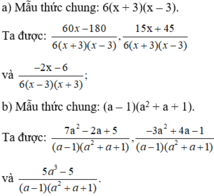Bài 4. Đưa các phân thức sau về cùng mẫu thức: a, x^3-2^3/x^2-4 và 3/x+2 b, 1/x-2 ; 2/2x-4 ; 3/3x-6

Những câu hỏi liên quan
Đưa các phân thức sau về cùng mẫu thức: a) (x^2-4x+4)/(x^2-2x) và (x+1)/(x^2-1) b) (x^3-2^3)/(x^2-4) và 3/(x+2)
a: \(\dfrac{x^2-4x+4}{x^2-2x}=\dfrac{\left(x-2\right)^2}{x\left(x-2\right)}=\dfrac{x-2}{x}=\dfrac{\left(x-2\right)\left(x-1\right)}{x\left(x-1\right)}\)
\(\dfrac{x+1}{x^2-1}=\dfrac{1}{x-1}=\dfrac{x}{x\left(x-1\right)}\)
b: \(\dfrac{x^3-2^3}{x^2-4}=\dfrac{x^2+2x+4}{x+2}\)
3/x+2=3/x+2
Đúng 2
Bình luận (1)
1.viết phân thức sau dưới dạng những phân thức có cùng mẫu thức
a) x^2 và x/x+1
b)x/2y và y/x
c)2x+y/x^3-y^3 và x+y/x
d)x+1/x^5.y^4 và 1-x/x^4.y^5
2.viết các phân thức sau dưới dạng những phân thức có cùng tử thức
a)1/x và x-2/x+3
b)x/y và y/x
c)x^2-y^2/2x^2 -xy và x+y/x
d)x^3.x^2/x-y và x^2.y^3/x+y
Đưa phân thức về cùng mẫu thức
\(\frac{4x}{x^3+12x^2+48x+64}\) và \(\frac{x-4}{4x^3+32x^2+64x}\)
\(x^3+12x^2+48x+64=x^3+3.x^2.4+3.x.4^2+4^3=\left(x+4\right)^3\)
\(4x^3+32x^2+64x=4x\left(x^2+8x+16\right)=4x\left(x+4\right)^2\)
\(\frac{4x}{\left(x+4\right)^3}=\frac{16x^2}{4x\left(x+4\right)^3},\frac{x-4}{4x\left(x+4\right)^2}=\frac{x^2-16}{4x\left(x+4\right)^3}\)
V . CÁC PHÉP TOÁN VỀ PHÂN THỨC :Bài 1 : Thực hiện các phép tính sau : b) x+3/x-2+4+x/2-x Bài 2 : Thức hiện các phép tính sau : a) x+1/2x+6+2x+3/x2+3x d) 3/2x2y +5/xy2 + x/y3 e) x/x-2y +x/x+2y + 4xy/4y2-x2 g) x+3/x+1 +2x-1/x-1 +x+5/X2-1 ;
Đọc tiếp
V . CÁC PHÉP TOÁN VỀ PHÂN THỨC :
Bài 1 : Thực hiện các phép tính sau :
b) x+3/x-2+4+x/2-x
Bài 2 : Thức hiện các phép tính sau :
a) x+1/2x+6+2x+3/x2+3x
d) 3/2x2y +5/xy2 + x/y3
e) x/x-2y +x/x+2y + 4xy/4y2-x2
g) x+3/x+1 +2x-1/x-1 +x+5/X2-1 ;
Bài 1:
b: \(=\dfrac{x+3-4-x}{x-2}=\dfrac{-1}{x-2}\)
Bài 2:
a: \(=\dfrac{x+1}{2\left(x+3\right)}+\dfrac{2x+3}{x\left(x+3\right)}\)
\(=\dfrac{x^2+x+4x+6}{2x\left(x+3\right)}=\dfrac{x^2+5x+6}{2x\left(x+3\right)}=\dfrac{x+2}{2x}\)
d: \(=\dfrac{3}{2x^2y}+\dfrac{5}{xy^2}+\dfrac{x}{y^3}\)
\(=\dfrac{3y^2+10xy+2x^3}{2x^2y^3}\)
e: \(=\dfrac{x^2+2xy+x^2-2xy-4xy}{\left(x+2y\right)\left(x-2y\right)}=\dfrac{2x^2-4xy}{\left(x+2y\right)\cdot\left(x-2y\right)}=\dfrac{2x}{x+2y}\)
Đúng 0
Bình luận (0)
Đưa các phân thức sau về cùng mẫu thức:a)
10
x
+
3
,
5
2
x
−
6
và
1
9
−
3
x
với
x
≠
±
3
;
b)
7...
Đọc tiếp
Đưa các phân thức sau về cùng mẫu thức:
a) 10 x + 3 , 5 2 x − 6 và 1 9 − 3 x với x ≠ ± 3 ;
b) 7 a 2 − 2 a + 5 a 3 − 1 , 1 − 3 a a 2 + a + 1 và 5 với a ≠ 1 .
Viết các phân thức sau thành các phân thức cùng mẫu:
1) \(\dfrac{2x-1}{x-2}\)và\(\dfrac{x+y}{2-x}\)
2) \(\dfrac{-y}{y-4}\)và\(\dfrac{y-x}{4-y}\)
\(\dfrac{x+y}{2-x}=\dfrac{-\left(x+y\right)}{x-2}\)
\(\dfrac{-y}{y-4}=\dfrac{--y}{4-y}=\dfrac{y}{4-y}\)
Đúng 1
Bình luận (1)
Cho hai phân thức \(\frac{x^3-x^2-x+1}{x^4-2x^2+1}\),\(\frac{5x^3+10x^2+5x}{x^3+3x^2+3x+1}\) . Theo bài tập 8 có vô số cặp phân thức có cùng mẫu thức và bằng cặp phân thức đã cho. Hãy tìm cặp phân thức như thế với mẫu thức là đa thức có bậc thấp nhất
EM MỚI LỚP 3 LÊN EM KO BIẾT GÌ HẾT
CHẮC CHỊ HOẶC ANH NÊN TRA GOOGLE
Tham khảo lấy nguồn từ Vietjack.com

cho hai phân thức \(\frac{x^3-x^2-x+1}{x^4-2x^2+1},\frac{5x^3+10x^2+5x}{x^3+3x^2+3x+1}\).Theo bài tập 8,có vô số cặp phân thức có cùng mẫu thức và bằng cặp phân thức đã cho.Hãy tìm cặp phân thức như thế với mẫu thức là đa thức có bậc thấp nhất
GIÚP MÌNH VỚI MỌI NGƯỜI ƠI!!!!!!!!!!!!!!!!!!!!!!!!!!!!!!!!
chuyên mục là Rút gọn phân thức bài 11 trang 17 SBT toán 8
Đưa các phân thức sau về cùng mẫua) dfrac{x}{2x^2+7x-15}; dfrac{x+2}{x^2+3x-10}; dfrac{1}{x+5}b) dfrac{1}{-x^2+3x-2}; dfrac{1}{x^2+5x-6}; dfrac{1}{-x^2+4x-3}c)dfrac{3}{x^3-1}; dfrac{2x}{x^2+x+1}; dfrac{x}{x-1}d)dfrac{x}{x^2-2xy+y^2-x^2}; dfrac{y}{x^2+2yz-y^2-z^2}; dfrac{z}{x^2-2xz-y^2+z^2}
Đọc tiếp
Đưa các phân thức sau về cùng mẫu
a) \(\dfrac{x}{2x^2+7x-15}\); \(\dfrac{x+2}{x^2+3x-10}\); \(\dfrac{1}{x+5}\)
b) \(\dfrac{1}{-x^2+3x-2}\); \(\dfrac{1}{x^2+5x-6}\); \(\dfrac{1}{-x^2+4x-3}\)
c)\(\dfrac{3}{x^3-1}\); \(\dfrac{2x}{x^2+x+1}\); \(\dfrac{x}{x-1}\)
d)\(\dfrac{x}{x^2-2xy+y^2-x^2}\); \(\dfrac{y}{x^2+2yz-y^2-z^2}\); \(\dfrac{z}{x^2-2xz-y^2+z^2}\)
a: \(\dfrac{x}{2x^2+7x-15}=\dfrac{x}{\left(x+5\right)\left(2x-3\right)}=\dfrac{x^2-2x}{\left(x+5\right)\left(x-2\right)\left(2x-3\right)}\)
\(\dfrac{x+2}{x^2+3x-10}=\dfrac{x+2}{\left(x+5\right)\left(x-2\right)}=\dfrac{\left(x+2\right)\left(2x-3\right)}{\left(2x-3\right)\left(x+5\right)\left(x-2\right)}\)
\(\dfrac{1}{x+5}=\dfrac{\left(2x-3\right)\left(x-2\right)}{\left(2x-3\right)\left(x-2\right)\left(x+5\right)}\)
b: \(\dfrac{1}{-x^2+3x-2}=\dfrac{-1}{\left(x-1\right)\left(x-2\right)}=\dfrac{-\left(x+6\right)\left(x-3\right)}{\left(x-1\right)\left(x-2\right)\left(x+6\right)\left(x-3\right)}\)
\(\dfrac{1}{x^2+5x-6}=\dfrac{1}{\left(x+6\right)\left(x-1\right)}=\dfrac{\left(x-2\right)\left(x-3\right)}{\left(x+6\right)\left(x-1\right)\left(x-2\right)\left(x-3\right)}\)
\(\dfrac{1}{-x^2+4x-3}=\dfrac{-1}{\left(x-1\right)\left(x-3\right)}=\dfrac{-\left(x-2\right)\left(x+6\right)}{\left(x-1\right)\left(x-3\right)\left(x+6\right)\left(x-2\right)}\)
c: \(\dfrac{3}{x^3-1}=\dfrac{3}{\left(x-1\right)\left(x^2+x+1\right)}\)
\(\dfrac{2x}{x^2+x+1}=\dfrac{2x\left(x-1\right)}{\left(x-1\right)\left(x^2+x+1\right)}\)
\(\dfrac{x}{x-1}=\dfrac{x\left(x^2+x+1\right)}{\left(x-1\right)\left(x^2+x+1\right)}\)
Đúng 0
Bình luận (0)



















